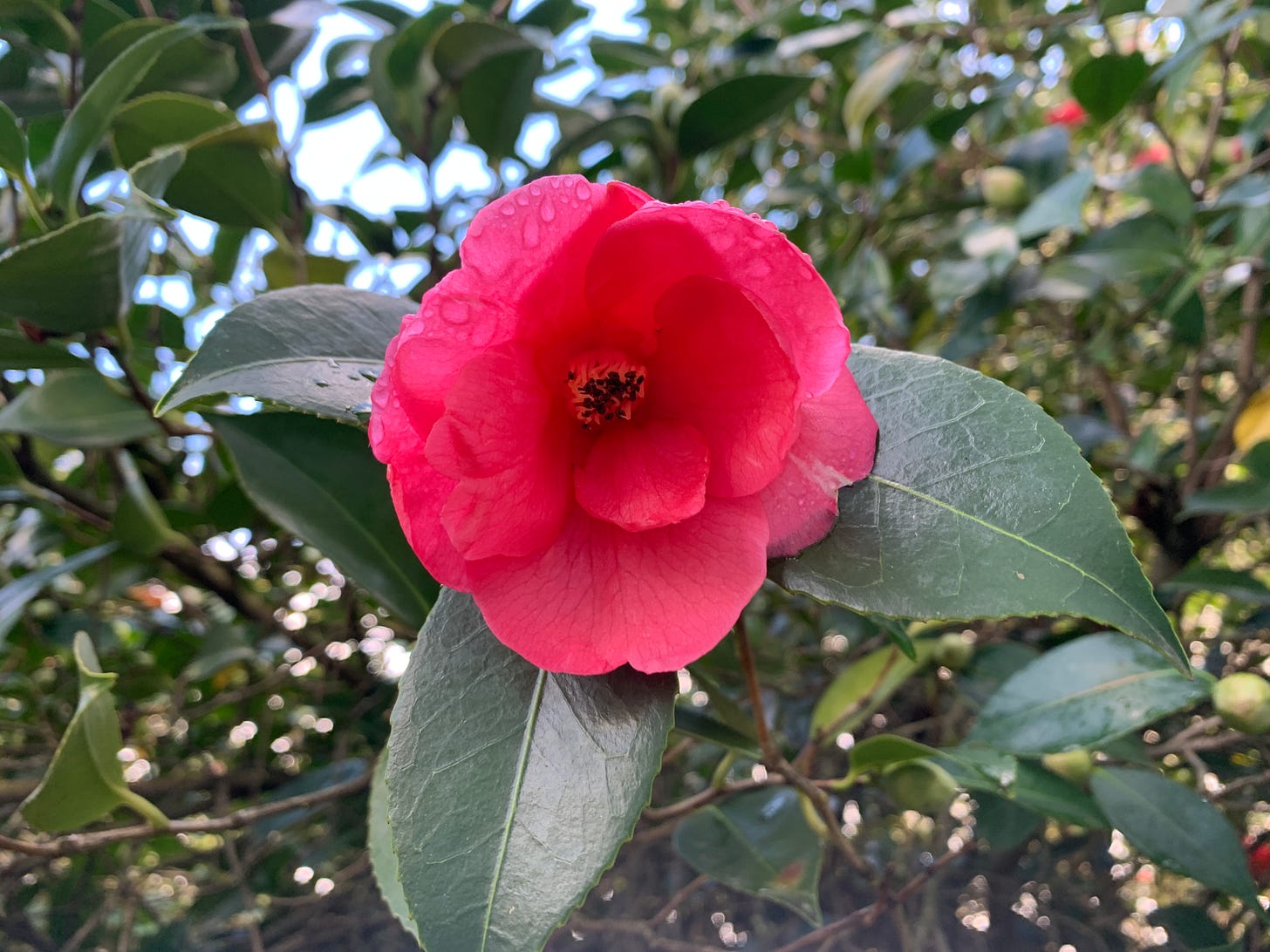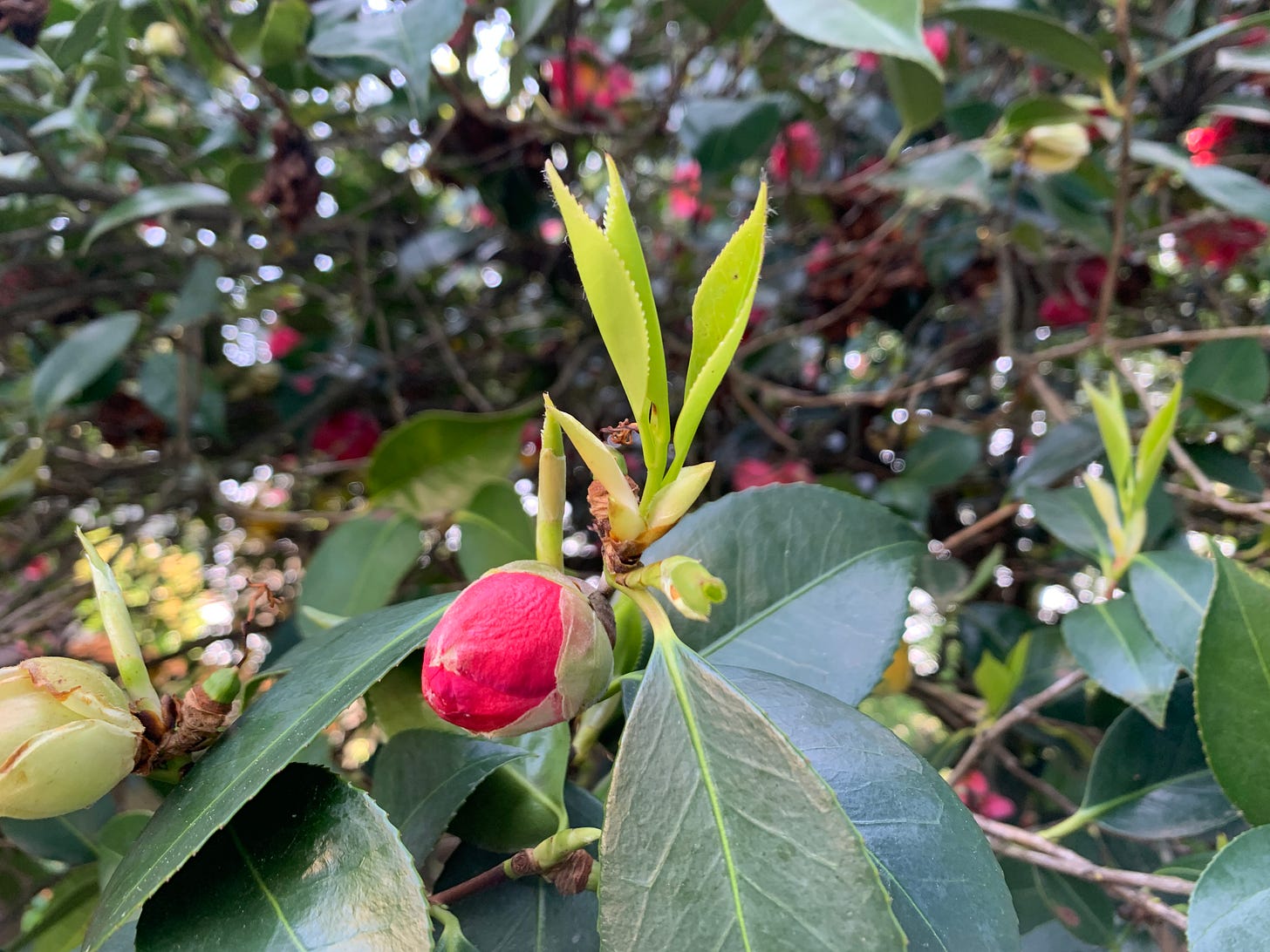Could failure be a gift? Sometimes, I suppose. I typed out this title yesterday morning, but I'm not sure I agree with it when it comes to this week's experiments. A more accurate sentiment might be that I am honored to join a long line of failed visionaries and disaster-prone optimists who just want to grow something that gives them joy.
I'm talking about making my own tea.
I am a secretive and reluctant tea nerd, slightly ashamed of my fascination with aged puerh teas from Yunnan, China, and leery of the online puerh community dominated by Millennial tea bros. About six weeks ago, when I was Googling the flowers in my yard to see which ones I could eat, I wondered how closely our giant Camellia japonica—whose hot-pink flowers give us so much delight in gloomy March—was related to Camellia sinensis, the species that most of the world's tea is made from.
The Portuguese and Brits brought C. japonica back to Europe four centuries ago, one of their many disastrous attempts to grow tea at home rather than pay Chinese tea merchants. Didn't make good tea, they decided. Still looks pretty. Guess we'll keep it.
There are now thousands of cultivars of this ornamental camellia across Europe and North America, and they do particularly well in the Pacific Northwest. Someone on YouTube made a few awkward-looking dishes with C. japonica flowers, so flower tea seemed possible, though the petals didn't taste that good when I nibbled on them. I emailed the Oregon Camellia Society to see if anyone had any experience with C. japonica tea, and several of them sent me the same link.
One member had a better suggestion: Why don't I wait until May and pick the freshly sprouted leaves?
That made more sense. From India to Japan, the first pale-green leaves to emerge after winter are the most flavorful and valuable. Heck, I already spend a chunk of cash every April to order just-picked green teas from China. And people aren't just making tea from Camellia sinensis. In Yunnan, some people make puerh and black tea from the closely related C. taliensis, though, to my palate, it tastes like a petrochemical mai tai. Taiwan-based tea makers are experimenting with the indigenous C. formosensis. A handful of research studies suggest that agronomists in Spain and Korea have even successfully made C. japonica tea. So have American homesteader bloggers and vloggers.
I've actually failed at making tea myself before. Back when I lived in Seattle, I drove north an hour to tour an experimental tea plot at the the Sakuma Brothers' berry farm in Washington's Skagit valley. As we wandered through 5 acres of lush C. sinensis bushes, owner Richard Sakuma let me pick a grocery bag's worth of spring buds and leaves. Driving home, the car smelled phenomenal, and the leaves I bruised and let oxidize overnight smelled even better. The fumes got me high on dreams of making Taiwanese-style oolong, so I rolled and roasted the leaves in a hot wok. I brought the finished product into work for my friend Laura, who had worked in a tea shop, to taste. "It's very faint," she said diplomatically, "But it tastes like tea?" I set the jar aside, and the contents molded over within a week—I hadn't roasted the leaves long enough to dry them out.
This week, a surge of late-April heat made pale-green, vertical leaf clusters sprout on the tips of our camellia's branches. I gathered several handfuls to make Japanese-style green tea with: I steamed the leaves for 45 seconds to stop them from oxidizing, then spread them out in the dehydrator. The warm air that wafted out smelled more like burned plastic than fragrant flowers.
That smell, unfortunately, carried through to the taste of the tea I brewed yesterday, dominated by the aromas of copper pipes and bolted cilantro. Was there any caffeine in this? Was my tongue getting itchy? I wasn't sure of either, and quickly rinsed out my mouth with something better.
My failure seems fitting, one tiny episode in a long struggle to replicate thousands of years of Chinese expertise in the U.S. Sure, there are small tea plantations in Mississippi, Hawaii, and Oregon. The latter, Minto Island Growers, sold me a scrawny, foot-high C. sinensis I have planted next to the blueberries. Last year's heat dome left it with 10 leaves. Now we’re playing a game of chicken to see which of us gives up first.
I want to commend those domestic successes, but I also have to mention the Sakuma Brothers tea gardens I visited in 2008, now killed off by pests. And Mike Fritts' Northern California oolongs, almost wiped out by the Paradise fire in 2018. And the legendary San Francisco tea merchant Roy Fong's expensive attempts to grow tea in a hot, dry valley near Sacramento, which seem stuck in limbo. In the 19th century, the British found a way to steal tea from China and make it flourish in colonial plantations staffed by indentured laborers. Modern-day American tea growers, by comparison, seem to be afflicted with a severe case of dreaminess.
I've come to admire Camellia sinensis for being so particular. For eluding America's swaggering confidence, our belief that we can engineer and research and bluff our way into doing everything better. I respect tea for demanding humans train for generations to grow and process its leaves into the beverage I love.
Perhaps, in another hundred years, Americans will grow top-quality tea. I don't have generations to wait. I'm content with my failures. I can’t believe that I’m admitting this publicly, but I already have enough tea stored away to last another decade.









Ooh! I didn't know you loved tea as much as I do! (Christian loves me despite that fact that I drink tea and not coffee...as long as I drink wine, he will hold on. Ha!) I turned to tea in my 20s after many attempts at trying to stop caffeine via diet sodas. I'm sure I've lost years of my life to that poison. It took two long bouts with the flu, but I finally broke the addiction and moved to tea. My grandmother was English so I figure I got the tea interest from her...she filled her coffee with cream and sugar to kill the taste yet happily drank tea as it was, maybe with a lemon slice.
When Christian and I were first dating, he brought me first pull tea as a gift. I instantly fell in love with him. Now, I drink my select favorite teas and pine for the English tea house that closed in downtown Portland many years ago. The tea ceremony at the Lan Su Garden is lovely, by the way. I have a lovely tea set from the garden to remind me to occasionally give myself the gift of taking time with tea.
I also have dreamed of growing my own tea after seeing that it was grown in Mississippi. Given that I'm not much of a gardener, your post helped me realize that I need to shelve that dream and just keep supporting my favorite tea purveyors.
Nothing like a good cupa tea and a good book in a rainy day! I prefer herbal ones that i mix the dry leaves according to my mood. But once I went to a Japanese tea ceremony in San Francisco and I loved it! They really know how to do it and to take time to rest and appreciate beauty and taste!